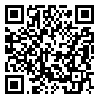BibTeX | RIS | EndNote | Medlars | ProCite | Reference Manager | RefWorks
Send citation to:
URL: http://gnf.khu.ac.ir/article-1-2901-en.html
2- Amirkabir University of Technology (Tehran Polytechnic)
3- Iranian Space Research Center (ISRC)
Today, remote sensing in geology efficiently identifies alteration zones and suitable locations for hydrothermal deposits. In the present study, satellite image processing techniques are employed to highlight the alteration zones in the Zafarghand exploration area. Zafarghand, located in the northeast of Isfahan, falls within the Central Iran zone according to geological structural zoning (the middle part of the Urumieh-Dokhtar magmatic arc). The Zafarghand porphyry system includes phyllic, potassic, propylitic, argillic, and silicic alteration halos. In this study, ASTER sensor images are used to identify the associated alterations. Due to the raster and digital nature of satellite images, the digital number (DN) values of each pixel in the image matrix are considered as samples in a systematic grid. Ultimately, the singularity method algorithm, as a structural approach for effectively separating geochemical anomalies, is applied to the DN values of ASTER satellite images. Additionally, the fuzzy gamma operator was used to integrate available information layers from the study area, including the lithological layer, fault density, false color composite with ASTER bands 468 (RGB) based on new DN values (calculated α values), and the Cu geochemistry layer. The results from this technique demonstrate that the singularity method, due to its structural nature, is successful in decision-making and effectively identifies alteration zones in the Zafarghand area, particularly propylitic and phyllic alterations. Furthermore, it was observed that the fuzzy gamma operator, using the proposed technique in this study, successfully highlights prospective Cu mineralization areas in the Zafarghand exploration area.
Received: 2024/05/26 | Accepted: 2024/08/7 | Published: 2024/09/2
| Rights and permissions | |
 |
This work is licensed under a Creative Commons Attribution-NonCommercial 4.0 International License. |







